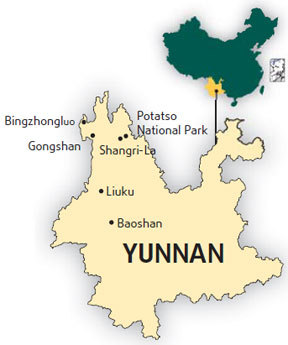
In 2006, Ding became deputy director of Potatso National Park Tourism Development Company and began building up the park.
The new park is 10 times bigger than the Bita Lake reserve.
"That means we can put more unprotected primitive forests and pasturelands under protection by establishing the park," Chen says.
About 70 km of blacktop roads have been built to connect the park's two major scenic spots, Shudu and Bita lakes. The roads also serve as fire separation strips. Plank roads stretch 10 km along the crystal-clear lakes to protect the surrounding wetlands.
Seven carefully designed "green toilets" are also used to minimize pollution. Completely powered by solar panels, these clean restrooms feature waterless urinals, take-away bag toilets and emit the smell of cedar rather than the more common public restroom odor.
Sixty-five green-colored shuttle buses, meeting Euro III emissions standards, can take visitors to scenic spots scattered in the park, while private cars must be left behind at the park entrance.
On Oct 15 this year, two new-type electric boats were delivered to the park from Shanghai and will soon replace the two motorboats serving on the Bita Lake.
Also, the local villagers' horse rentals have been banned, Ding says.
"But the park has spent 3 million yuan (US$439,800) every year in compensating the villagers' losses from the park's limitations on horse rentals and overgrazing," he says.
"Among 2,000 people living in and close to the park, 504 who live within the park, will receive compensation of 2,000 yuan per person per year."
Meanwhile, the park has hired more than 200 employees. Most of them, Ding says, are from the local Tibetan communities.
"We require that their levels of education are higher than primary school," he says. "Only after we failed to find enough qualified people at the neighboring communities did we turn to other parts of the county."
In 2007, the park's income was over 100 million yuan (US$14.6 million). Good tour guides can earn 4,000-5,000 yuan a month in the peak season, the director says. And the employees have various training opportunities.
"TNC has often sent experts to train our employees," he says. "We sent 60 of our workers to study at Jiuzhaigou Scenic Area in Sichuan province last year."
The park has earned 80 million yuan so far in this year. With more income, the park can invest more in conservation.
"Every year we will pay 60-70 million yuan off our 200-million loan from bank," Ding says. "But we will still give 500,000 to 600,000 yuan from our profits to the Bita Lake reserve, which has been a Ramsar site of Wetlands of International Importance."
Without the responsibility of tourism management, the reserve rangers can focus on their regular patrols, monitoring and research.
After a four-year effort, the reserve also began breeding local fish after cooperating with Kunming Zoology Institute of Chinese Academy of Sciences.
"In the near future, we will promote breeding of the fish in the local communities," Ding says. "It might benefit both the local economy and the endangered species' survival."
The park's attention to the slightest environmental impact resulting from infrastructure can be seen at nearly every step.
The visitors' reception center is built with wood and stone in local Tibetan style; walking trails that circle the lakes and traverse wetlands are slightly elevated to permit water-flow and allow light penetration to foster vegetation growth beneath the walkways; garbage bins, park maps, road signs, and signs about the area's unique fauna and flora are everywhere.
Walking on the plank roads for only a few minutes, visitors can see wild ducks feeding in Shudu Lake and crows strolling on the plank road.
At the park's highest lookout, which is over 4,000 m above sea level, one can see Bita Lake encircled by marshes and forests. The snowy peaks of the Tianbao Mountains loom above the tree line in the distance.